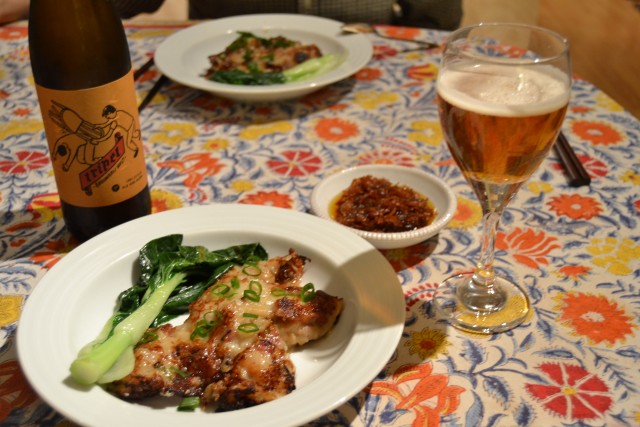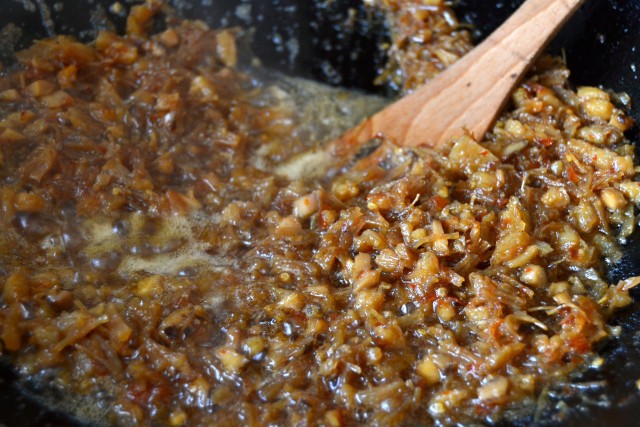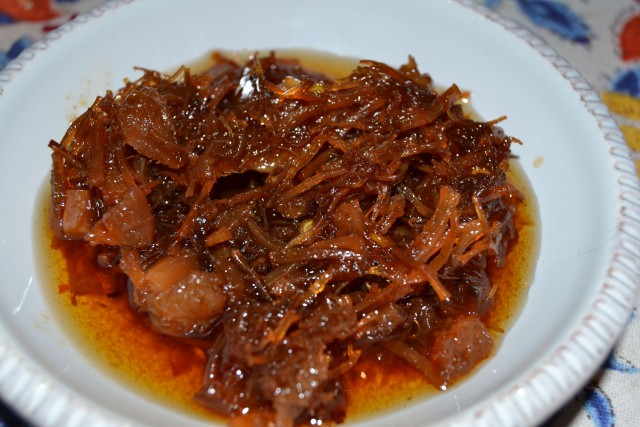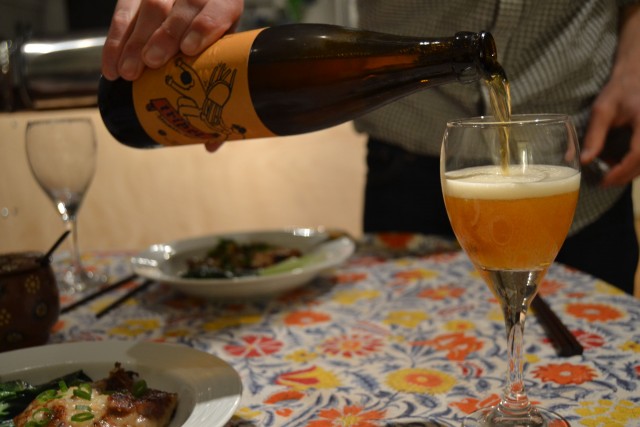
All day to do as I pleased, all night to gorge on cheese: this was my MLK weekend mantra. It was the start of the
Winter Fancy Food Show at the Moscone Center, so Chris was away meeting luminaries of the gourmet world while I puttered about at home, varying my errands with cooking projects until it was time to attend a cheese party. Feeling a little fancy myself, I made two Cantonese foods I’d never attempted before: XO sauce, a spicy condiment chock-full of umami; and
loh bak goh (turnip cake), my
favorite dim sum and a commonly served breakfast during Chinese New Year as it symbolizes prosperity.
I decided to pair the loh bak goh with beer, a Belgian-style
tripel. I thought it would work well, given how tripels generally are very flavorful and sweetly spicy on the palate with fruity, bubblegum-like flavors, yet finish dry like a cider. More importantly, the pairing would go toward one of my life’s goals to break through a lager ceiling that stretches across Asia. Why do all Asian countries invariably make far more lager than any other style of beer? Think about it: Kingfisher (India), Tiger (Singapore), OB (South Korea), Tsingtao (China), Asahi (Japan), Chang (Thailand) … etcetera, etcetera, etcetera as
Yul Brynner would say. I suppose the logic is that it's really hot in many countries in Asia, at least for part of the year, so a cooling sip of alcoholic water kissed with malt isn’t a bad idea, regardless of what you’re eating.
But surely more creative beers can rise to the top and unseat the aforementioned brands! The Asian craft beer revolution WILL happen! Comrades, to the barricades with tulip glasses! Uh oh, now I’m on my Sapporo-box, and should get back to the stove.
XO Sauce and loh bak goh are actually great to make together if you have the time, as the XO sauce involves a lot of downtime for soaking, which you can use for the turnip cake’s active-time prep. I watched a few different XO sauce YouTube videos and read a few online recipes, ultimately settling on
this one from a Singaporean food blogger. I soaked all of the ingredients for the XO sauce and the turnip cake in warm water to speed the reconstituting process before pedaling to the Berkeley farmers market to get a Chinese turnip, a variant of daikon, from my favorite Asian vegetable vendor.

Upon returning, I started on the turnip cake. Lots of recipes exist online, and I used
this one from the Canadian Broadcasting Corporation, as it’s well known that some of the best Cantonese chefs are working in the Great White North. Canada was on my mind anyway, I was missing my best friend in HK, a Toronto native and a great eating buddy.
After grating the daikon and cutting up the Chinese sausage for the loh bak goh, I turned my attention to the XO sauce. Feeling a bit lazier at this point, I whizzed up the shallots, garlic and reconstituted dried chilies in a bowl with an immersion blender, instead of deep frying the shallots separately. I stir-fried the shallots, garlic and chilies together in a generous amount of peanut oil before adding the seafood and mushrooms:

I also added just one tablespoon of oyster sauce since I wanted the dried scallop, shiitake mushroom and shrimp to shine -- my Mom always impressed upon me how precious these ingredients are, and never to diminish their presence. My XO sauce had more of an earthen hue as a result:

I then got back to the loh bak goh. One big flaw of the recipe, I discovered, was this step: “Add the wheat and rice flours to the loh bak a little at a time until it is all incorporated.” Adding dry flours to a hot pan didn’t seem like a good idea at the time, and a third of the way through slowly adding the rice and wheat flour mix to the wok, I realized it wasn’t as the flours started to stick to the bottom of the wok. I abandoned the recipe’s instructions and put the mix from the wok -- 1/3 of the flours and the partially cooked shredded loh bak -- into a mixing bowl. Then I added all of the flours plus the soaking liquid, and then the Chinese sausage, dried scallop and shiitake, and seasonings. As with the XO sauce, I went light on the oyster sauce, and before steaming the cake in a parchment-lined loaf pan, I sprinkled the top with scallions and toasted sesame seeds.

After steaming was complete, I left it to set in the fridge and went to the
Cheesemonger Invitational before tasting it with the tripel as a midnight snack.
As you may have deduced from the photo below, the lok bak goh did NOT turn out texturally correct — it was more gloppy than desired, and did not hold the firm, angular shape of the loaf pan after steaming and setting in the fridge. The dish didn’t set as solidly as it should have because I took the loh bak shreds and starch out of the wok. In reading other recipes, I found that it is necessary to complete this step in a pot on the stove, not a bowl, to evaporate some of the liquid and also to activate the flours’ glutens. In the future, I’ll mix the flours with the soaking liquid before adding it to a cool, non-stick pot, then turning on the burner to low and slowly stirring for a few minutes until the mixture has the consistency of a thick glue. Whatever vessel you choose, keep it on low heat so the starches don’t clump. Hopefully I won’t be seeing a loh bak goh that’s this amorphous next time:

Luckily, the sweetness of the sausage and the concentrated dried seafood flavors met head on with the tripel from
Brouwerij West, a brewery based in my hometown of Palos Verdes, CA! We didn't get the "firm bitterness" noted on on the site's tasting note, due to the waves of umami inherent in the loh bak goh -- a plus to my palate as I don't prefer that note.
A dubbel could work as well, but why have dubbel happiness when you can have tripel?

In case you’re wondering, I got a head start on my Chinese New Year foods as today is the first day of a 12-day
Herbal D-tox cleanse, which means that my meals for the next few weeks will be rather limited and not blog-worthy as I’ll be abstaining from anything fermented. The whole process will be documented here on Umami Mart so stay tuned and I’ll see you on the other side.
*Raised on beef oatmeal and the logic of using chopsticks instead of a whisk, Audrey’s earliest exposures to eating and cooking extend to the present where she finds joy in discovering novel food and beverage pairings. She lives in the San Francisco Bay Area with her home-brewing turophile husband and their collection of kitchen gadgets, bicycles and wine maps.
 All day to do as I pleased, all night to gorge on cheese: this was my MLK weekend mantra. It was the start of the Winter Fancy Food Show at the Moscone Center, so Chris was away meeting luminaries of the gourmet world while I puttered about at home, varying my errands with cooking projects until it was time to attend a cheese party. Feeling a little fancy myself, I made two Cantonese foods I’d never attempted before: XO sauce, a spicy condiment chock-full of umami; and loh bak goh (turnip cake), my favorite dim sum and a commonly served breakfast during Chinese New Year as it symbolizes prosperity.
I decided to pair the loh bak goh with beer, a Belgian-style tripel. I thought it would work well, given how tripels generally are very flavorful and sweetly spicy on the palate with fruity, bubblegum-like flavors, yet finish dry like a cider. More importantly, the pairing would go toward one of my life’s goals to break through a lager ceiling that stretches across Asia. Why do all Asian countries invariably make far more lager than any other style of beer? Think about it: Kingfisher (India), Tiger (Singapore), OB (South Korea), Tsingtao (China), Asahi (Japan), Chang (Thailand) … etcetera, etcetera, etcetera as Yul Brynner would say. I suppose the logic is that it's really hot in many countries in Asia, at least for part of the year, so a cooling sip of alcoholic water kissed with malt isn’t a bad idea, regardless of what you’re eating.
But surely more creative beers can rise to the top and unseat the aforementioned brands! The Asian craft beer revolution WILL happen! Comrades, to the barricades with tulip glasses! Uh oh, now I’m on my Sapporo-box, and should get back to the stove.
XO Sauce and loh bak goh are actually great to make together if you have the time, as the XO sauce involves a lot of downtime for soaking, which you can use for the turnip cake’s active-time prep. I watched a few different XO sauce YouTube videos and read a few online recipes, ultimately settling on this one from a Singaporean food blogger. I soaked all of the ingredients for the XO sauce and the turnip cake in warm water to speed the reconstituting process before pedaling to the Berkeley farmers market to get a Chinese turnip, a variant of daikon, from my favorite Asian vegetable vendor.
All day to do as I pleased, all night to gorge on cheese: this was my MLK weekend mantra. It was the start of the Winter Fancy Food Show at the Moscone Center, so Chris was away meeting luminaries of the gourmet world while I puttered about at home, varying my errands with cooking projects until it was time to attend a cheese party. Feeling a little fancy myself, I made two Cantonese foods I’d never attempted before: XO sauce, a spicy condiment chock-full of umami; and loh bak goh (turnip cake), my favorite dim sum and a commonly served breakfast during Chinese New Year as it symbolizes prosperity.
I decided to pair the loh bak goh with beer, a Belgian-style tripel. I thought it would work well, given how tripels generally are very flavorful and sweetly spicy on the palate with fruity, bubblegum-like flavors, yet finish dry like a cider. More importantly, the pairing would go toward one of my life’s goals to break through a lager ceiling that stretches across Asia. Why do all Asian countries invariably make far more lager than any other style of beer? Think about it: Kingfisher (India), Tiger (Singapore), OB (South Korea), Tsingtao (China), Asahi (Japan), Chang (Thailand) … etcetera, etcetera, etcetera as Yul Brynner would say. I suppose the logic is that it's really hot in many countries in Asia, at least for part of the year, so a cooling sip of alcoholic water kissed with malt isn’t a bad idea, regardless of what you’re eating.
But surely more creative beers can rise to the top and unseat the aforementioned brands! The Asian craft beer revolution WILL happen! Comrades, to the barricades with tulip glasses! Uh oh, now I’m on my Sapporo-box, and should get back to the stove.
XO Sauce and loh bak goh are actually great to make together if you have the time, as the XO sauce involves a lot of downtime for soaking, which you can use for the turnip cake’s active-time prep. I watched a few different XO sauce YouTube videos and read a few online recipes, ultimately settling on this one from a Singaporean food blogger. I soaked all of the ingredients for the XO sauce and the turnip cake in warm water to speed the reconstituting process before pedaling to the Berkeley farmers market to get a Chinese turnip, a variant of daikon, from my favorite Asian vegetable vendor.
 Upon returning, I started on the turnip cake. Lots of recipes exist online, and I used this one from the Canadian Broadcasting Corporation, as it’s well known that some of the best Cantonese chefs are working in the Great White North. Canada was on my mind anyway, I was missing my best friend in HK, a Toronto native and a great eating buddy.
After grating the daikon and cutting up the Chinese sausage for the loh bak goh, I turned my attention to the XO sauce. Feeling a bit lazier at this point, I whizzed up the shallots, garlic and reconstituted dried chilies in a bowl with an immersion blender, instead of deep frying the shallots separately. I stir-fried the shallots, garlic and chilies together in a generous amount of peanut oil before adding the seafood and mushrooms:
Upon returning, I started on the turnip cake. Lots of recipes exist online, and I used this one from the Canadian Broadcasting Corporation, as it’s well known that some of the best Cantonese chefs are working in the Great White North. Canada was on my mind anyway, I was missing my best friend in HK, a Toronto native and a great eating buddy.
After grating the daikon and cutting up the Chinese sausage for the loh bak goh, I turned my attention to the XO sauce. Feeling a bit lazier at this point, I whizzed up the shallots, garlic and reconstituted dried chilies in a bowl with an immersion blender, instead of deep frying the shallots separately. I stir-fried the shallots, garlic and chilies together in a generous amount of peanut oil before adding the seafood and mushrooms:
 I also added just one tablespoon of oyster sauce since I wanted the dried scallop, shiitake mushroom and shrimp to shine -- my Mom always impressed upon me how precious these ingredients are, and never to diminish their presence. My XO sauce had more of an earthen hue as a result:
I also added just one tablespoon of oyster sauce since I wanted the dried scallop, shiitake mushroom and shrimp to shine -- my Mom always impressed upon me how precious these ingredients are, and never to diminish their presence. My XO sauce had more of an earthen hue as a result:
 I then got back to the loh bak goh. One big flaw of the recipe, I discovered, was this step: “Add the wheat and rice flours to the loh bak a little at a time until it is all incorporated.” Adding dry flours to a hot pan didn’t seem like a good idea at the time, and a third of the way through slowly adding the rice and wheat flour mix to the wok, I realized it wasn’t as the flours started to stick to the bottom of the wok. I abandoned the recipe’s instructions and put the mix from the wok -- 1/3 of the flours and the partially cooked shredded loh bak -- into a mixing bowl. Then I added all of the flours plus the soaking liquid, and then the Chinese sausage, dried scallop and shiitake, and seasonings. As with the XO sauce, I went light on the oyster sauce, and before steaming the cake in a parchment-lined loaf pan, I sprinkled the top with scallions and toasted sesame seeds.
I then got back to the loh bak goh. One big flaw of the recipe, I discovered, was this step: “Add the wheat and rice flours to the loh bak a little at a time until it is all incorporated.” Adding dry flours to a hot pan didn’t seem like a good idea at the time, and a third of the way through slowly adding the rice and wheat flour mix to the wok, I realized it wasn’t as the flours started to stick to the bottom of the wok. I abandoned the recipe’s instructions and put the mix from the wok -- 1/3 of the flours and the partially cooked shredded loh bak -- into a mixing bowl. Then I added all of the flours plus the soaking liquid, and then the Chinese sausage, dried scallop and shiitake, and seasonings. As with the XO sauce, I went light on the oyster sauce, and before steaming the cake in a parchment-lined loaf pan, I sprinkled the top with scallions and toasted sesame seeds.
 After steaming was complete, I left it to set in the fridge and went to the Cheesemonger Invitational before tasting it with the tripel as a midnight snack.
As you may have deduced from the photo below, the lok bak goh did NOT turn out texturally correct — it was more gloppy than desired, and did not hold the firm, angular shape of the loaf pan after steaming and setting in the fridge. The dish didn’t set as solidly as it should have because I took the loh bak shreds and starch out of the wok. In reading other recipes, I found that it is necessary to complete this step in a pot on the stove, not a bowl, to evaporate some of the liquid and also to activate the flours’ glutens. In the future, I’ll mix the flours with the soaking liquid before adding it to a cool, non-stick pot, then turning on the burner to low and slowly stirring for a few minutes until the mixture has the consistency of a thick glue. Whatever vessel you choose, keep it on low heat so the starches don’t clump. Hopefully I won’t be seeing a loh bak goh that’s this amorphous next time:
After steaming was complete, I left it to set in the fridge and went to the Cheesemonger Invitational before tasting it with the tripel as a midnight snack.
As you may have deduced from the photo below, the lok bak goh did NOT turn out texturally correct — it was more gloppy than desired, and did not hold the firm, angular shape of the loaf pan after steaming and setting in the fridge. The dish didn’t set as solidly as it should have because I took the loh bak shreds and starch out of the wok. In reading other recipes, I found that it is necessary to complete this step in a pot on the stove, not a bowl, to evaporate some of the liquid and also to activate the flours’ glutens. In the future, I’ll mix the flours with the soaking liquid before adding it to a cool, non-stick pot, then turning on the burner to low and slowly stirring for a few minutes until the mixture has the consistency of a thick glue. Whatever vessel you choose, keep it on low heat so the starches don’t clump. Hopefully I won’t be seeing a loh bak goh that’s this amorphous next time:
 Luckily, the sweetness of the sausage and the concentrated dried seafood flavors met head on with the tripel from Brouwerij West, a brewery based in my hometown of Palos Verdes, CA! We didn't get the "firm bitterness" noted on on the site's tasting note, due to the waves of umami inherent in the loh bak goh -- a plus to my palate as I don't prefer that note.
A dubbel could work as well, but why have dubbel happiness when you can have tripel?
Luckily, the sweetness of the sausage and the concentrated dried seafood flavors met head on with the tripel from Brouwerij West, a brewery based in my hometown of Palos Verdes, CA! We didn't get the "firm bitterness" noted on on the site's tasting note, due to the waves of umami inherent in the loh bak goh -- a plus to my palate as I don't prefer that note.
A dubbel could work as well, but why have dubbel happiness when you can have tripel?
 In case you’re wondering, I got a head start on my Chinese New Year foods as today is the first day of a 12-day Herbal D-tox cleanse, which means that my meals for the next few weeks will be rather limited and not blog-worthy as I’ll be abstaining from anything fermented. The whole process will be documented here on Umami Mart so stay tuned and I’ll see you on the other side.
*Raised on beef oatmeal and the logic of using chopsticks instead of a whisk, Audrey’s earliest exposures to eating and cooking extend to the present where she finds joy in discovering novel food and beverage pairings. She lives in the San Francisco Bay Area with her home-brewing turophile husband and their collection of kitchen gadgets, bicycles and wine maps.
In case you’re wondering, I got a head start on my Chinese New Year foods as today is the first day of a 12-day Herbal D-tox cleanse, which means that my meals for the next few weeks will be rather limited and not blog-worthy as I’ll be abstaining from anything fermented. The whole process will be documented here on Umami Mart so stay tuned and I’ll see you on the other side.
*Raised on beef oatmeal and the logic of using chopsticks instead of a whisk, Audrey’s earliest exposures to eating and cooking extend to the present where she finds joy in discovering novel food and beverage pairings. She lives in the San Francisco Bay Area with her home-brewing turophile husband and their collection of kitchen gadgets, bicycles and wine maps.




Comments (0)
There are no comments for this article. Be the first one to leave a message!